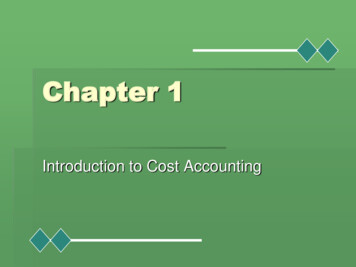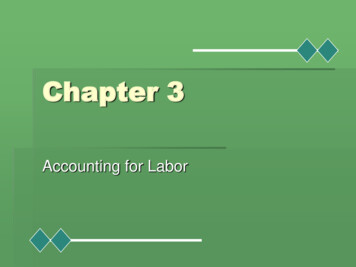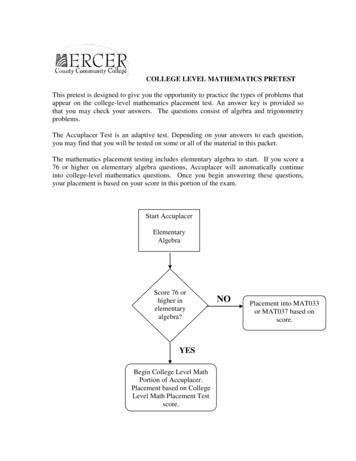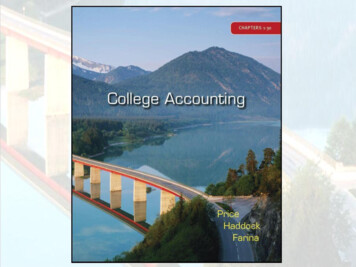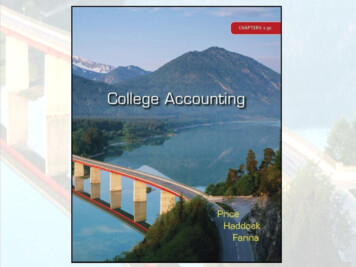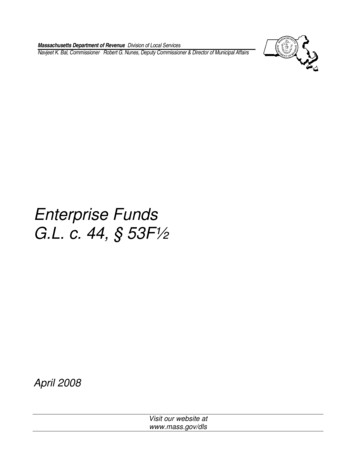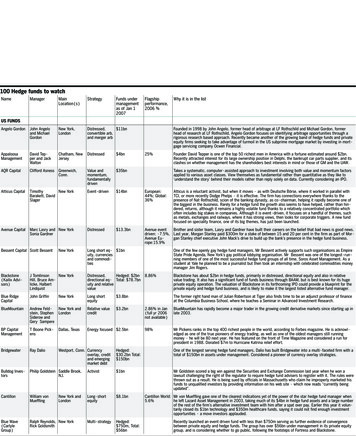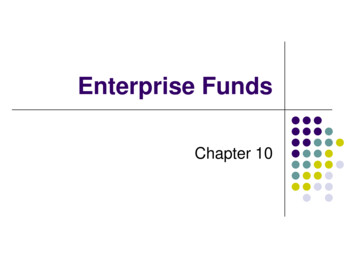
Transcription
Enterprise FundsChapter 10
Learning Objectives Determine what activitiesshould be reported usingEnterprise Funds.Understand the ProprietaryFund accounting principles.Understand ProprietaryFund reporting forintergovernmental grantrevenues and debtrefundings. Review typical ProprietaryFund transactions.Understand the formats &classifications of ProprietaryFund financial statements.Understand and be able tocompute the threecomponents of ProprietaryFund Net Assets.Prepare the ProprietaryFund financial statements.
Transition ChapterLeaving behind the newmaterial:Governmental FundAccounting & ReportingMoving to material thatwill look more familiar:Proprietary FundAccounting & Reporting
Common Characteristics &Principles Accounting EquationAccounting PrinciplesFinancial Statements
Accounting EquationTraditional Balance Sheet EquationCurrentAssets CapitalAssets OtherNoncurrentAssetsCurrentLiabilities Long-TermLiabilities NetAssetsORNew Net Asset EquationCurrentAssets CapitalAssets OtherNoncurrentAssetsCurrentLiabilities Long-TermLiabilitiesNetAssets
Accounting Principles Very similar to private sector counterpartsOften use fixed budgets May cause activity to be accounted for onbudgetary basis during the yearConverted to GAAP basis at end of the yearLegal or contractual reporting requirementsthat differ from GAAP met in CAFR or byissuing special purpose reports
Accounting Standards forProprietary Funds All Proprietary Funds follow: GASB StandardsCAP Bulletins, APB Opinions, and FASBStandards through #102, unless pronouncementconflicts with GASB StandardsGASB #20 requires governments to either Follow FASB Standards issued after #102, unlessit conflicts with GASB Standards, ORNot to apply subsequent standards [usual choice]
Financial Statements Statement of Fund Net Assets (or BalanceSheet)Statement of Revenues, Expenses, andChanges in Fund Net Assets (or Fund Equity)Statement of Cash Flows
Statement of Fund Net Assets Two formats allowed: Traditional Balance Sheet formatNew Net Asset formatEither way, statement must be classifiedStatement presents current and noncurrentassets and current and noncurrent liabilitiessimilar to private sectorWhat is different is the equity section
Categories of Fund Net Assets Invested in Capital Assets, Net of Related DebtRestricted Net AssetsUnrestricted Net AssetsContributed Capital and Retained Earnings nolonger used
Calculations of Net Asset Amounts Maintaining separate accounts during theyear unnecessary – amounts do not articulatewith other financial statementsTransactions may cause reclassificationsamong amounts – entry to recordunnecessaryAmounts usually calculated at year-end
Invested in Capital Assets,Net of Related DebtHistorical cost of capital assets– Accumulated Depreciation Net Book Value– Capital asset-related debt of the fund (adjustedfor unspent proceeds) Invested in Capital Assets, Net of Related Debt
Restricted Net Assets Amount of restricted assets in excess of noncapital borrowing and other liabilities payablefrom restricted assetsConstraints must be narrower than generallimits of activity
Restrictions Imposed By: Creditors, grantors, contributors, or laws andregulations of other governmentsConstitutional provisionsEnabling legislations that Authorizes government to assess, levy, charge orotherwise mandate payment of resourcesexternally, ANDPlaces legally enforceable purpose restriction onthose resources
Important Points aboutRestricted Net Assets Must be more limited than scope of activitiesaccounted for in fundMay not be reported as a negative amount – ifliabilities exceed assets, amount is reported as zeroand excess deducted from Unrestricted Net AssetsIf assets must be maintained in perpetuity, mustclassify Restricted Net Assets as expendable andnonexpendable (rare)Amount reported may be different than restrictedassets less liabilities payable from restricted assetsdue to classification problems
Calculation ofRestricted Net AssetsAssets restricted to a particular purpose– Noncapital liabilities directly associated with andpayable from restricted assets– Capital debt equal to unexpended proceeds ofcapital debt included in restricted assets Restricted Net Assets
Unrestricted Net Assets Remainder of net assets not reportedelsewhere (a “plug” number?)Designated by managementImportant points Designations are internal and may be changed bymanagementNot the same as expendable available financialassets like in Governmental FundsNot reported on face of statementVery rare in practice
Calculation ofUnrestricted Net AssetsAll other assets– All other liabilities Unrestricted Net AssetsORTotal Net Assets– Invested in Capital Assets, Net of Related Debt– Restricted Net Assets Unrestricted Net Assets
Statement of Revenues, Expenses, &Changes in Fund Net Assets
Key Difference from Private Sector All-inclusive approachRevenues reported net of uncollectibleaccounts and similar amountsNet income not reported in statementSpecial items and transfers unique toProprietary Fund reporting
Statement of Cash Flows Based on GASB #9 – issued 2 years afterFASB #95Several important differences Sections (GASB has 4; FASB uses 3)Direct method required (FASB allows eithermethod)Noncash transactions reported on face ofstatement (FASB #95 allows it to be reported innotes)
Sections of the SCF GASBOperating ActivitiesNoncapital FinancingActivitiesCapital and RelatedFinancing ActivitiesInvesting Activities FASBOperating ActivitiesFinancing ActivitiesInvesting Activities
Cash Flows fromOperating Activities Reflects only transactions affecting operatingincome (unlike FASB which includes alltransactions affecting net income)Excludes interest revenue and expenseSection is only one affected by requirementto use the direct method – reconciliation ofoperating income to cash flows fromoperating activities must still be presented
Cash Flows fromNoncapital Financing Activities Debt issued to finance operations, includingrelated interest reported in this sectionTransfers not related to capital acquisitionsreported here
Cash Flows fromCapital & Related Financing Activities Issuance and repayment of debt, includinginterest, issued to acquire capital assetsAcquisition and sale of capital assets(reported in FASB #95 investing section)
Cash Flows fromInvesting Activities Acquisition and subsequent sale ofinvestments in debt and equity instrumentsInterest and dividends received from suchinvestmentsMaking and collecting most loans (except foroperating loans which are reported inOperating Activities section)
Noncash Transactions Transactions not involving the actual flow ofcashExamples Signing a capital leaseCapital assets (or other noncash items) donatedto the Proprietary FundIssuing debt to acquire a capital assetUnrealized gains and losses on investments
Enterprise Funds vs.Internal Service Funds Enterprise FundsUsed to account foractivities that providegoods and servicesprimarily to the publicon a charge basisIf primary customersare internal togovernment, shouldreclassify as InternalService FundsInternal Service Funds Used to account foractivities that providegoods and services toother departments ofthe governmental unit If primary customersare external to thegovernment, shouldreclassify as EnterpriseFunds
When Use of Enterprise FundIs Required Activity is financed with debt that is securedsolely by a pledge of the net revenues fromfees and charges of the activityLaws or regulations require that the activity’scosts of providing services, including capitalcosts (such as depreciation or debt service),be recovered with fees and chargesPricing policies of the activity establish feesand charges designed to recover its costs,including capital costs
Common Examples of EFs Water & Sewer DepartmentsElectric UtilitiesGas UtilitiesSanitary Sewer OperationsGarbage and other waste collection & disposalservicesOff-street Parking Lots and GaragesSolid Waste LandfillsAirports
Governments may elect to useEFs even when not required Allows government to consistently use EFaccounting even when requirements notalways metGovernment seeks to report activity using fullcostGovernment seeking to make reporting morecomparable to other governments
Specific EF Topics Budgeting and appropriations practicesInterfund activityReporting grantsInterest capitalizationDebt refunding transactions
Budgeting and Appropriations Flexible budgets may be adopted to assist incontrol of operationsFixed budgets usually adopted because oflegal requirementsMany EFs operate on budgetary basis duringthe year and convert to GAAP at year-end
Interfund Activity Most transactions between EFs and GovernmentalFunds accounted for as interfund servicetransactionsBillings to other departments recorded as operatingrevenues“Free” services provided to other funds recognizedas Transfer to other fund with correspondingrevenueInterfund transfers are last item on operatingstatement
Intergovernmental Grants Capital grants restricted to construction, acquisition,or improvement of capital assets Reported on operating statement as first item after Incomebefore other revenues, expenses, and transfersReported in SCF as Capital and Related FinancingActivitiesOperating grants are all other grants Reported on operating statement as nonoperatingrevenuesReported on SCF as Noncapital Financing Activities
Interest Capitalization Interest cost on taxable debt follows guidanceof private sectorIf tax-exempt debt is used: Capitalization period starts when debt is issuedMust deduct interest earnings on temporaryinvestments in calculating interest cost to becapitalizedNo interest is capitalized on assets financedby restricted gifts or grants
Long-Term Debt Refundings Governmental Fund refundings discussed inChapter 8Private sector refundings discussed inFinancial Accounting coursesEF Refundings a whole new ball game
Essence of the RefundingDifferencesOld DebtWhere does difference go?100,00010,000New Debt110,000Governmental Funds – no gain or loss recorded; difference absorbed into OFUor Expenditures, as appropriate.Private Sector – extinguishment gain or loss (no longer extraordinary) in theperiod old debt is retired.Enterprise Funds – depends on funding sourceOwn resources: extraordinary gain or lossRefunding: gain or loss deferred and amortized
Situation #1 – No new debtBonds PayableLoss on Early Extinguishment of DebtUnamortized Discount on Bonds PayableUnamortized Bond Issue CostsCash[Page 402]1,935,00086,58235,0001,5821,985,000
Situation #1 – Refunding [Page 403]New Debt:CashUnamortized Refunding Bond Issue CostsRefunding Bonds PayableRetirement:Bonds Payable (old debt)Deferred Interest Expense AdjustmentUnamortized Discount on Bonds PayableUnamortized Bond Issue ,0001,5821,985,000
Deferred Interest ExpenseAdjustment Reported as deduction from (or addition to)Refunding BondsAmortized over shorter life of refunded bonds(old debt) and refunding bonds May use any rational systematic methodMost governments use straight-line method
Situation #1 – Interest effects[Page 403–404]Interest ExpenseCash80,000Interest ExpenseDeferred Interest Expense Adjustment –Refunding Bonds17,316Interest ExpenseUnamortized Refunding Bond Issue Costs80,00017,3161,5001,500
#1 EF established [Page 404]CashTransfer from GF400,000400,000
#2 Acquire existing plantLandBuildingsImprovements other than BuildingsMachinery & EquipmentAccounts ReceivableInventory of Materials and SuppliesAllowance for Uncollectible AccountsBonds PayableCompensated Absences PayableVouchers PayableDue to ABC Electric Company[Page 0,000100,00010,000280,000
#3 Pay amount due [Page 405]Due to ABC Electric CompanyCash280,000280,000
#4 Close Transfer accountTransfer from GFNet Assets[Page 405]400,000400,000Note use of Net Assets account. Governments usually don’t use separate NetAsset classifications. Aforementioned calculations are made at year-end.
#5 Ordering and receiving materials:Consumption method required [Page 405]Order materialsOn a GAAP basis, no entry.Receive materialsInventory of Materials & SuppliesVouchers Payable59,00059,000
#6 Bill customers [Page 405]Accounts ReceivableOperating Revenues300,000300,000
#7 Purchase equipment onaccount [Page 405]Machinery & EquipmentVouchers Payable50,50050,500
#8 Nonoperating Revenue:Rent [Page 405]Due from State Public Works DepartmentNonoperating Revenues – EquipmentRental7,0007,000
#9 Cash collections [Page 406]CashAccounts ReceivableNonoperating Revenues – Interest291,000290,0001,000
#10 Bill from ISF for services[Page 406]Operating ExpensesDue to ISF12,80012,800
#11–12 Cash payments [Page 406]#11 Bond principal and interestBonds PayableNonoperating Expenses – InterestCash#12 Operating expensesOperating ExpensesVouchers PayableCash50,00020,00070,000139,20070,000209,200
#13 Transfer to General Fund[Page 406]Enterprise FundTransfer to GFCash10,000General FundCashOFS – Transfer from EF10,00010,00010,000
#14 Donation from a developer[Page 406]Improvements Other than BuildingsOther Revenues – Capital Contributions30,00030,000
#15 Federal grant receivedCashNonoperating Revenues – Intergovernmental Grants[Page 406]100,000100,000
#16a Adjusting Entries: Accruals[Page 407]Operating ExpensesNonoperating Expenses – InterestAccrued Salaries & Wages PayableAccrued Interest PayableAccrued Utilities PayableCompensated Absences Payable13,5002,0004,5002,0007,5001,500
Other Adjusting Entries [Page 407]16b Unexpired InsurancePrepaid InsuranceOperating Expenses16c Change in supplies inventoryOperating ExpensesInventory of Materials & Supplies16d Bad DebtsOperating RevenuesAllo
Retirement: Bonds Payable (old debt) Deferred Interest Expense Adjustment Unamortized Discount on Bonds Payable Unamortized Bond Issue Costs Cash 1,985,000 15,000 1,935,000 86,582 2,000,000 35,000 1,582 1,985,000. Deferred Interest Expense Adjustment Reported as deduction from (or addition to) Refunding Bonds Amortized over shorter life of refunded bonds (old debt) and refunding bonds
